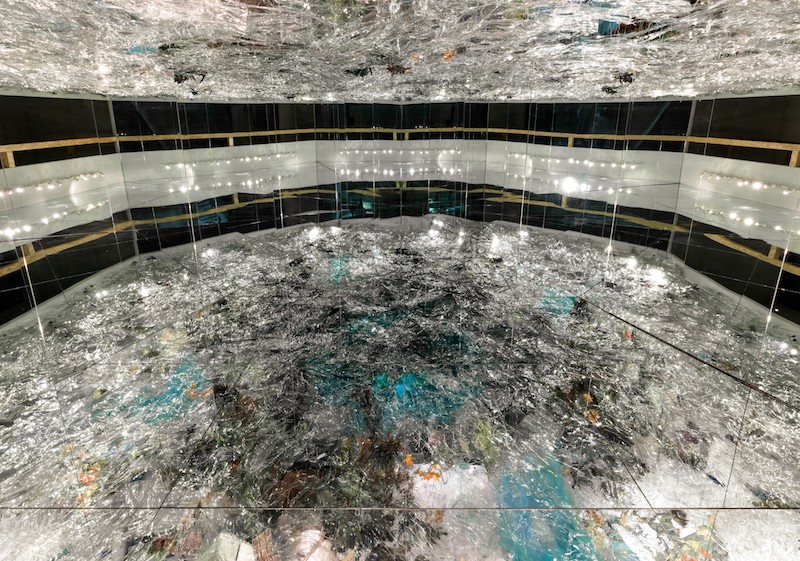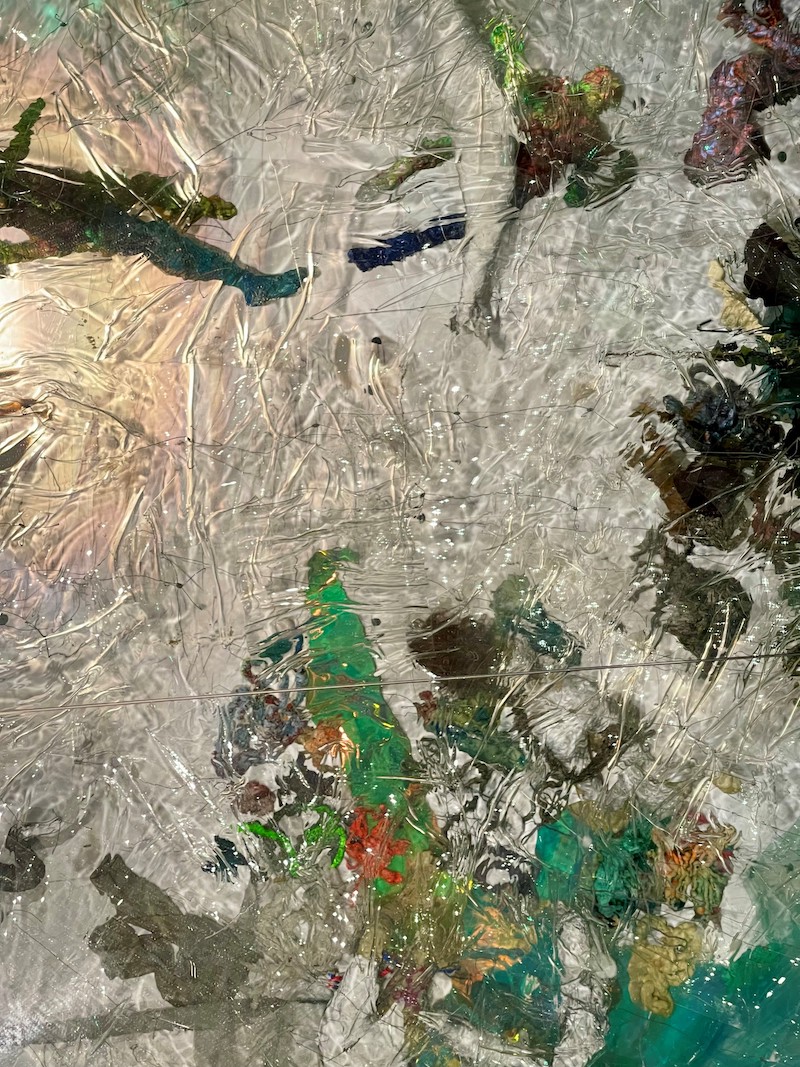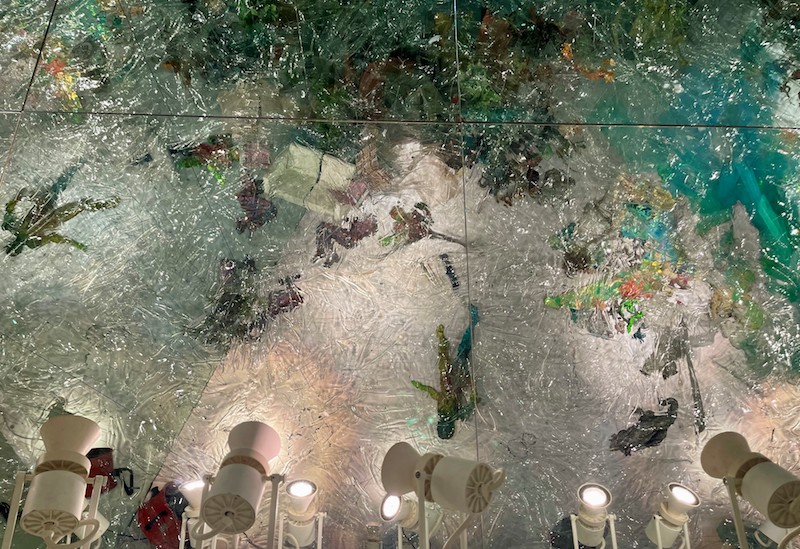by Trey Burns // Oct. 8, 2024
In a darkened lower gallery of the Nasher Sculpture Center, a purpose-built ramp leads visitors to the edge of an architectural kaleidoscope. Inside, painted foam creatures, broken furniture and plastic plants splay outward into the infinite regress that has become Samara Golden’s signature. We are presented with a recursive landscape, half rendered or half decomposed, between dreams and nightmares. Dangling lights catch the breeze from oscillating fans, their flickering reflections adding a dizzying layer to the flooded tangle.

Samara Golden: ‘if earth is the brain then where is the body,’ 2024, Nasher Sculpture Center, Dallas, Texas, dimensions variable, mixed media // © Samara Golden, photo by Kevin Todora, courtesy of Nasher Sculpture Center
Los Angeles-based artist Samara Golden has been making a name for herself with her installations for over a decade. Her unique form of the broken funhouse could easily fall into the trap of being “ready for the gram” and the growing trend towards the “experiential spectacle” in the institutional art world, but here, thankfully, it does not. In fact, this work feels particularly subdued and well-tuned to resist photographic coherence.
Growing up, Golden’s father worked as an architectural photographer. In our interview outside the gallery, she fondly recalled when her father landed a gig documenting nursing homes in West Virginia. She worked as his assistant, helping do little things to arrange scenes, “like bringing flowers from the other room.”
Today, Golden’s process involves assembling and composing her works on-site. She explained, “I believe in creating a situation where I have all the elements for something to happen and I’m waiting for what it needs to become.” At the press preview, the gallery smelled of heavy lacquer and the off-gassing of plastics. Curator Catherine Craft candidly noted that the installation had been completed just the night before, and she was still searching for the right words to explain the exhibition. This palpable sense of a dress rehearsal, combined with the toxic freshness of the set, heightened the work’s stagecraft.

Samara Golden, ‘if earth is the brain then where is the body (detail),’ 2024, Nasher Sculpture Center, Dallas, Texas, dimensions variable, mixed media // © Samara Golden, photo by the artist
This brought to mind Daguerre’s early dioramas and the meticulous care he put into crafting simulated landscapes. First exhibited in Paris in the early 1800s at a specially designed theater, Daguerre’s proto-cinematic “installations” combined scenic paintings with sculptural objects. Like Golden, Daguerre used controlled lighting and translucency to create scenes that subtly shifted and evolved before the viewer’s eyes. These dioramas served as a crucial bridge between traditional landscape painting and emerging technologies, foreshadowing innovations in cinema. Similarly, Golden’s work seems to edge us toward the fully immersive realities that linger just beyond the horizon of our contemporary moment.
During her early site visits to the Nasher, Golden recalled seeing airplanes reflected in the mirror-clad buildings of Dallas’s post-modern skyline. This context feels particularly compelling for her work, as Dallas itself can resemble a hall of illusions—reflecting and refracting a distorted image of itself, often suggesting more than is actually present. In contrast, her hand-crafted sculpture’s tattered spray foam surfaces (aquatic fauna and human figures) convey a gentle earnestness. These small, expansive scenes depict a sunken world, submerged and perhaps frozen in the aftermath of some fast-moving cataclysm, encasing these delicate forms and suggesting a vulnerability that feels immediate.

Samara Golden, ‘if earth is the brain then where is the body (detail),’ 2024, Nasher Sculpture Center, Dallas, Texas, dimensions variable, mixed media // © Samara Golden, photo by the artist
Looking across the installation, I was reminded of Ursula K. Le Guin’s feverish short story ‘The New Atlantis’ (1975). In this dystopian narrative, set in a future where environmental collapse has led to rapidly rising sea levels, the protagonist learns of a new continent emerging from the ocean. The story flickers between two threads: a tale of love and survival and a mysterious parallel dimension where new forces, strange creatures and seemingly different physical laws begin to manifest.
In my conversation with Samara Golden, she echoed a similar desire to transcend the confines of reality: “I want to make something you can’t make on earth, and you can’t make it with the laws of the world that we live in.” This sentiment resonates with Le Guin’s narrative, where a bystander observes, “The old continents are sinking, to make room for the new.” For Golden, mirrors serve as imperfect tools—portals to a disoriented world of her own making and “like in a dream, one thing unfolds into another, and unfolds another, defying logic.”
Exhibition Info
Nasher Sculpture Center
Samara Golden: ‘if earth is the brain then where is the body’
Exhibition: Sept. 28, 2024-Jan. 12, 2025
nashersculpturecenter.org
2001 Flora St, Dallas, TX 75201, USA, click here for map























